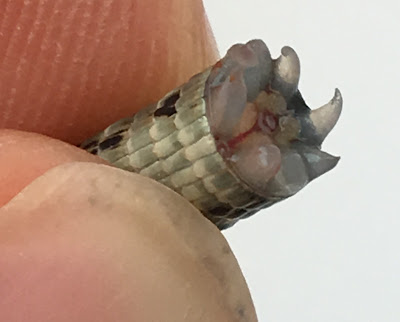Autotomie de queue (Tail autotomy)
The phenomena of tail autotomy (from the Greek auto for ‘self’ and tome for ‘cut’ or ‘severing’) in lizards has elicited the curiosity
and attention of biologists for a long, long time as it is the only example of
a vertebrate losing an appendage by voluntary shedding (a recent issue of one of my favorite journals, Physiological and Biochemical Zoology, was dedicated to this topic). The tail is able to essentially drop off quickly and easily
because of modified muscle, bone, and tissue structures. Without getting into
too much anatomical detail, the tail is made up of interlocking
segments that can quickly detach from each other at a fracture plane (see some
nice images of a gecko tail in Sanggaard et al. 2012). The exposed tissue on the lizard’s tail rapidly contracts and
loses very little blood, allowing the animal to escape, even if not completely
intact.
 |
| The anterior end of a dropped tail. Notice the geometric fracture planes and lack of blood. |
Dropping a tail like this generally plays a single important functional role in the life of a lizard: it allows that individual to escape from a would-be predator. To make sure this happens, after autotomy the tail’s job isn’t over. It will continue to writhe, its movements drawing the predator’s attention while the lizard flees. The muscles in the tail can do this by relying on anaerobic respiration and this can last for up to 30 minutes! In the particular case of this wall lizard, the tail wriggled for about 5 minutes or so in an eerie display of dedication to its former body.
While this behaviour can certainly save a lizard’s life, it
is also quite costly. The tail is important to lizards in many ways, including
aiding in locomotion, providing stability for jumping and landing, playing a
role in social signaling, and as an important source of energy stores. In fact,
some lizards will return to their tail after dropping it and – if the coast is
clear – eat it themselves! Given this, there are numerous factors that
influence how and when a lizard will drop its tail, the consequences of this
action, and how the tail can regenerate.
 |
| Relationships among various factors involved in tail autotomy and regrowth (from Higham et al. 2013). |
 |
| Still images from video of jumping lizards with and without a tail. Notice in the bottom-right panel how the lizard without a tail jumps with a different angle than the lizard with a tail (from Gillis et al. 2009). |
After autotomy, lizards will regenerate their tails, but this is energetically costly. And unfortunately the new tail won’t be quite a nice as the original. Nonetheless, this process of tissue regeneration and re-growth is being studied to address important biomedical applications in human tissue (such as how aspects of the nervous system may regenerate, see Tanaka and Ferretti 2009). Given the number of times we observe re-grown tails in wild lizards (and the number of times I’ve seen it happen myself), it is certainly a common and widespread occurrence. For the lizards I collected this week, we will only keep them in captivity for a few weeks before releasing them, so I’m curious to see if we see any signs of tail regeneration in that short period of time. And though I’m confident that this little guy will be OK, I learned to be even more deliberate and careful in handling these lizards.
 |
| A regenerated tail in a wild-caught lizard. |


Comments
Post a Comment